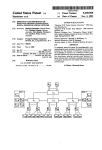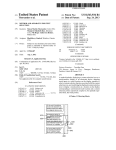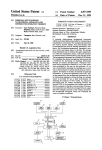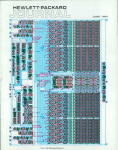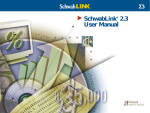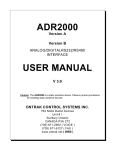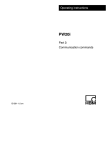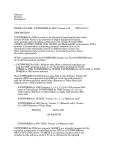Download Activation of a dormant sibling computer in a communication
Transcript
Hl l l l l l l l l l Il l l l l l l l l l l l l l l l l l l l l l l l l l . USO05289578A United States Patent [19] [11] Patent Number: Hartheimer et al. [45] [54] ACTIVATION OF A DORMANT SIBLING 5,191,651 COMPUTER IN A COMMUNICATION 5,198,805 NETWORK BY OVERRIDING A UNIQUE DORMANT NODE ADDRESS WITH A COMNION ACTIVE NODE ADDRESS 5,289,578 Date of Patent: Feb. 22, 1994 3/1993 Halim et al. ........... .. 395/200 3/1993 Whiteside m1. ........... .. 340/825.06 OTHER PUBLICATIONS Quotron Systems, Inc., “Quotron F/X Trader System [75] Inventors: Richard Hartheimer, Morris Plains, N.J.; Michael Coleman, Sydney, Australia; Chris Klepka, Parsippany, N.J.; Geoffrey Poole, Sydney, Australia Overview,” Winter 1989/90. Quotron Systems, Inc., “Quotron F/X Trader Beta Version User Manual,” Spring 1990. Quotron Systems, Inc., “Quotron F/X Trader Beta Version System Administration Manua ,” Spring 1990. Quotron Systems, Inc., “Interactive Demo Script”, with copies of display screens as shown in Lisbon, Por [73] Assignee: Foreign Exchange Transaction Services, Inc., Long Island City, NY. App]. No.: 612,045 [21] tugal, Spring/Summer 1989. [22] Filed: No. 5 Oct. 1980 pp. 1811-1812. Nov. 9, 1990 J. G. Sarns; “Node Processor for Distributed System Control”; IBM Technical Disclosure Bulletin; vol. 23 Primary Examiner-Parshotam S. Lall [52] US. Cl. .................................. .. 395/200; 395/575; [58] Field of Search ............... .. 395/575, 200; 371/91; 364/242.96; 364/284.4; 364/285; 370/60; 370/93; IMO/825.07 364/187; 370/60, 93; 340/82507 Assistant Examiner-Krisna Lim Attorney, Agent, or Finn-Robbins, Berliner & Carson [57] ABSTRACT A respective unique dormant address is permanently associated with each of two sibling computers located References Cited at a particular node of a communications network. A U.S, PATENT DOCUMENTS selected one of the sibling computers is activated by [56] associating an overriding common active node address 4,775,976 10/1988 Yokoyama ............................ .. 37l/9 . 4,823,256 4/1989 Bishop et a1. 4,920,484 4/1990 Ramada __________ n 4,920,375 395/575 5/1990 Mercer et a1. .. 4,975,838 12/1990 Mizuno er a], ____ ,_ 4,977,499 12/1990 Banning et a1. . 4,985,830 1/ 1991 Atac et a1. . . . . . . . . . . . 5939930 3/1991 ASSCYS =1 a1- ---- a 395/200 ...... .. 395/575 395/575 . . . with the selected computer. App11cat1on programs run . . . . . nmg at other nodes of the network utilize this active node address and thus interface with Whichever Sibling 395/200 computer is identi?ed by the active node address. Ac cordingly, the dormant computer and its physical con . . . .. 395/200 nection to the network may be monitored by the com 340/506 munications software using its unique dormant address 2,0583%? 10/1991 _ Hamfner etlal' 395/575 and the dormant computer is always available to re ’058’ 0/1991 Mom? 61 a ' 5 086 384 2/1992 Fukada 5,121,486 6/1992 Kurihara et al. 395/575 364/187 395/325 place the active computer in a manner that is transpar ent to any other computers connected to other nodes of the netwmk 5,077,655 12/1991 5,125,076 l/l992 .lmzaki ...., . . .. . . . .. Faber et al. . . . . . 395/200 . . . .. 395/200 5,167,035 11/1992 Mann et a1. ....................... .. 395/575 2 Claims, 6 Drawing Sheets B41 BANK x ‘12 -—-BANK NODES <34 CITY NODE T111 T B4N _B,1 c1 [ c2 CITY NODE CITY NODE BANK Y T311 c3 9 cmr NODE TT 3‘ ; 312 T113 THN BANK NODES , TS‘IN 512 . . . Bm / . 521 . T121 T1214 T1141 T1142 TlMN T211 T21N 82M . 83M . . . T2141 T2NN T3111 T5NN 532 . f TERMINALS T321 TszN ‘J US. Patent Feb. 22, 1994 Sheet 2 of 6 E\. 5,289,578 2\ 2r58.$S&l36i21%m\?5:0 35m.B8N1aI2s58.zE;: i253283:. 5 E53.$i-l1m?368w.;: 3$80.<16952K38:;w Q.E1F12:q?35.Q6250?:m8 N.wE .2\.52$36.%95;: N.5:6+mS 5£320:189 EU ~ / 2 US. Patent Feb. 22, 1994 Sheet 3 of 6 5,289,578 Bonk Node Modem| } } DECrouier DECrou’rer~19 18/ L“"l 21" F‘J N Micro ‘5 [Modem \BH VAX r h ‘5.41%22 Micro 17~ VAX 22 [ ==]~_T111 Fig. 3 T112 [ -]g€ US. Patent Feb. 22, 1994 Sheet 4 of 6 ADMINISTRATOR INSTRUCTS ACTIVE NODE ?n T0 co IDLE ACTIVE NODE PROMPTS ADMINISTRATOR $27 AS TO TIME DELAY I WARNING MESSAGE DISPLAYED r28 AT TERMINALS CONNECTED TO BANK NODE I I ACTIVE NODE HALTS ADMINISTRATOR INVOKES STARTUP PROCEDURE ON IDLE NODE f I PREVIOUSLY IDLE NODE (NOW ACTIVE) SENDS MESSAGE TO TERMINALS CONNECTED TO BANK NODE Fig. 4 31 5,289,578 US. Patent Feb. 22, 1994 Sheet 5 of 6 5,289,578 EXTRACT NODE TYPE AND ACTIVE NODE ADDRESS "35 FROM SIGNATURE FILE 36 IS THE NODE A DUPLEX NODE? CHECK REACHABILITY OF ACTIVE NODE 38 ” ADDRESS 59 IS ACTIVE NODE ADDRESS UNREACHABLE? EXTRACT ACTIVE NODE [42 NAME FROM SIGNATURE FILE Fig. 5A US. Patent Feb. 22, 1994 Sheet 6 of 6 5,289,578 IS DECneI UP‘? NO GET EXECUTOR ADDRESS 4‘ EXECUTOR ADDRESS DIFF. FROM ACTIVE NODE ADD.? SHUT DECnet DOWN K49 oSTOP NETWORK EVENT LOGGER PROCESS (IF RUNNING) oSET EXECUTOR ADDRESS TO ACTIVE NODE ADDRESS oSET EXECUTOR NAME TO ACTIVE NODE NAME oSTART UP DECne'r 51 (i?) Fig. 5B 1 5,289,578 2 address, and the network must be aware of the unique ACTIVATION OF A DORMANT SIBLING address of each computer in order to access it. COMPUTER IN A COMMUNICATION NETWORK Prior art addressing schemes are generally cumber BY OVERRIDING A UNIQUE DORMANT NODE some. For example, in one scheme (where a network ADDRESS WITH A COMMON ACTIVE NODE 5 has a main and backup computer at a ?rst node, and a ADDRESS plurality of other nodes, the structure of the other nodes being unimportant), the address that the other nodes use TECHNICAL FIELD The present invention relates generally to a computer based communications network, and more particularly to a method of operating a dormant sibling computer at a particular node of the communications network so that it may selectively be made accessible to application programs resident in other computers. to access the two computers at the ?rst node must be changed from the address of the main computer to the address of the backup computer. However, this puts a large burden on each of the network nodes to recognize when the addresses must be changed. SUMMARY OF THE INVENTION The present invention provides a method for identify CROSS-REFERENCE TO RELATED ing redundant sibling computers in a communications APPLICATIONS network having at least one node with a pair of sibling For a more comprehensive view of what is presently computers, one normally active and the other normally regarded as the best mode of practicing the invention dormant. The sibling computer are identi?ed by perma and its intended environment, reference should be made 20 nently associating a unique dormant address to each to the following commonly assigned US patent appli sibling computer, selecting one of the computers to be cations ?led concurrently herewith on Nov. 2, 1990: active and thereafter associating an overriding common “Detection and prevention of Duplicate Trading active address to the selected computer. Any applica Transactions over a Communications Network” tion programs running on the network need only spec 25 (115. patent application Ser. No. 07/608,642) ify the common active address for that particular node “Financial Exchange System Having Automated in order to interface with whichever sibling computer 15 Recovery/Rollback of Unacknowledged Orders” (U .S. patent application Ser. No. 07/608,643) “Terminal for Automated Trading System having Streamlined User Interface” (U.S. patent applica has been selected as the active computer at that node. While one sibling computer is in active mode, the other sibling computer must be in dormant mode. The 30 two sibling computers cannot be active at the same tion Ser. No. 07/608,645) time; however, both of them can be in dormant mode The following documents published by Quotron Sys simultaneously. These constraints are ensured by an tems, Inc. describe various aspects of a trading system appropriate start-up process for each sibling computer. which embodies many aspects of the present invention When each computer is started up, it ?rst determines 35 and which is available for commercial use under the trademark “F/X Trader”: “Quotron F/X Trader System Overview,” Winter whether any other sibling computer in the node is iden ti?ed by the common active node address. If it is not, then the sibling computer may assume its active mode 1989/90. “Quotron F/X Trader Beta Version User Manual,” by temporarily removing itself from the network, Spring 1990. “Quotron F/X Trader Beta Version System Admin istration Manual,” Spring 1990. nect itself to the network. changing its network address to equal the active node address, and using that active node address to re'con Copies of the foregoing documents are included as part BRIEF DESCRIPTION OF THE DRAWINGS of the above-cited application entitled “Detection and Prevention of Duplicate Trading Transactions Over a 45 Other objects and features of the present invention will be apparent from the following description of a Communications Network” and are hereby incorpo rated by reference. presently preferred embodiment taken in connection with the accompanying drawings, in which: BACKGROUND ART FIG. 1 is a system level schematic representation of a A computer network comprises a plurality of nodes 50 city network system having bank nodes connected thereto; that are connected together to allow for the exchange FIG. 2 is a schematic diagram illustrating an exem of data between computers located at different nodes. plary display screen of the trading system having a In most networks, certain of the computers are particu larly critical and a serious degradation of functionality results if such a computer malfunctions, or otherwise is 55 plurality of windows disposed therein; FIG. 3 is a schematic diagram of an exemplary net inaccessible, for an extended period of time. Not only is work node having sibling computers; communication with the faulty computer interrupted, FIG. 4 is a flowchart illustrating, in general, an exem plary method used by a node administrator to swap sibling computers at a bank node; and FIGS. 5A and 5B are ?owcharts illustrating the start but any associated network functions performed by the computer remain unexecuted, potentially causing con siderable havoc. The magnitude of this problem can be reduced by providing two computers at each node, for example a main and a backup computer. Thus, when the main computer breaks down, the backup computer can take its place. However, implementing a system that can 65 switch computers at the nodes can be dif?cult. The difficulty arises from the fact that each computer con nected to the network must be identi?ed by a unique up sequence of a sibling computer ensuring that only one computer at the node is active. DETAILED DESCRIPTION OF THE PREFERRED EMBODIMENT Referring initially to FIG. 1, an exemplary network of trading terminals is shown. The network comprises a plurality of city nodes C1 to C4, each connected to at 3 5,289,578 4 least one bank node B11 to B4M. Each bank node is in turn connected to at least one trading terminal T111 to routers 18 and 19 (such as DECrouter 200s) and a switch 21 (such as a DELNI). The function of each T3MN. The bank and city nodes generally provide a routing network and supervisory functions to allow a component is conventional. Brie?y, the routers route signals to and from other nodes. The routers at the bank node route signals to and from a city node and to and trading terminal connected to one bank node to commu nicate with a trading terminal (or trading terminals) connected to another bank node (or bank nodes). The from trading terminals corresponding to the bank node. The switch allows either siblingv computer to connect with either router. In addition to these components, the bank node com understanding of the present invention. Suffice it to say that the city nodes may be located in any city, and the 10 prises other conventional elements, such as at least one monitor and keyboard (not shown) for operating the city nodes may be connected in any combination neces sibling computers, modems 23 connected to the DECr sary to facilitate the routing of calls from city to city outers for facilitating the input/output connection of and from bank node to bank node. For example, the city the DECrouters to other nodes, and printers 22 con nodes may be located in the cities indicated in FIG. 1 nected to the sibling computers. wherein city node C1 is located in Tokyo, city node C2 In an exemplary embodiment, the sibling computers in New York, city node C3 in Zurich and city node C4 run DECnet which is a communications software pack in London. age. Although a complete understanding of the opera The route over which messages are routed is invisible tion of DECnet is not necessary for an understanding of to the traders using the trading terminal. For example, a foreign exchange trader using the trading terminal T111 20 the present invention, it is helpful to understand that DECnet allows messages to be routed, by means of the in Bank X in Tokyo can communicate with a foreign DECrouters, between computers at different nodes of trader using the terminal T311 at Bank Y in Zurich. The the network. When DECnet is up and running at a bank message from Bank X to Bank Y initiates at terminal node, that node is available to the network to transmit T111, is routed through the bank X bank node B11 and then through the Tokyo city node C1. Upon receipt of 25 and receive messages. However, when DECnet is down at a bank node, that node is not available for transmis the message at Bank Y, it gets routed to the Zurich city sion and reception of any messages, and that node can node, then to the Bank Y bank node B31 and ?nally to be considered to be removed from the network. the trading terminal T311. The path that the message At any one time, when the bank node is functioning takes between the Tokyo C1 and Zurich C4 city nodes detail of the network structure is not important to an is entirely up to the decision making function of the 30 as a network element, one of the sibling computers is active and the other is dormant and the network (i.e. the network. For example, the message may go through other nodes in the network) identi?es the bank node New York C2 only, or London C3 only, or both New through recognition of a “published address” installed York and London before reaching Zurich. ~ on the active computer. Although it is possible for both There are a variety of messages and communications which can occur between traders, however, the most 35 of the sibling computers to be dormant at the same time, only one of the sibling computers can be active at any fundamental is a communication regarding the negotia one time. This condition is ensured by the present in tion of the sale or purchase of currency. Brie?y, in an vention. exemplary system, the trading conversation is initiated More speci?cally, each of the sibling computers has a by one trader requesting a quote (RFQ) from another trader. The other trader has a variety of options, the 40 unique address when in the dormant state, i.e., its dor ?rst of which includes whether he will even answer the mant node address. Each sibling computer can commu nicate with the network using its dormant node address. However, a single active node address, or published or sending written messages back to the requesting address, is shared between the computers. When one party. The conversation is ended by either making a 45 sibling computer is identi?ed by the active node ad deal or refusing a deal and hanging up. dress, the other sibling computer is identi?ed by its Referring now to FIG. 2, an exemplary trading termi unique dormant address. For example, when the ?rst nal screen is shown having a plurality of panels. An sibling computer 16 is identi?ed by the active node indicative rates panel 11 is provided and contains elec address, the second sibling computer must be identi?ed tronically updated indicative trading rates for selected currency pairs, wherein a currency pair is the two types 50 by its unique dormant address, and vice versa. It is important to note that each of the sibling comput of currency which are to be involved in the potential ers is connected to the network, and can communicate transaction. Example of currencies are the US. dollar with the network, regardless of whether it is in an active (USD), the Great Britain pound (GBP), the Deutsche or dormant state. This is of particular bene?t because [German] mark (DEM), the Japanese yen (J PY) and the 55 the operability of the dormant computer can be moni French franc (FRF). tored at any time since it is always part of the network. An incoming call queue panel 12 is also provided. Further, since both of the sibling computers are al This panel prioritizes and displays the incoming calls ways connected to the network, switching between arriving at the bank node to which the trading terminal them is simpli?ed. Switching the active node address is connected. Calls may also be sent to a particular trader, in which case this too is indicated in the incom 60 from one sibling computer to another may be required where the active computer fails thus necessitating the ing call queue panel. The remaining panels are conver dormant computer to be activated. Switching between sation panels 13. It is in these panels that conversations sibling computers may also occur as a preventive mea between traders take place. The six conversation panels sure, such as where the active computer has a minor allow each trader to simultaneously conduct six trading 65 failure or where preventive maintenance must be per transactions. formed on the computer. As shown in FIG. 3, an exemplary duplex bank node In an exemplary embodiment, the switching of the B11 has a ?rst and second sibling computer 16 and 17 RFQ. Other options include responding with a quote, respectfully (such as MicroVAX computers), a pair of sibling computers is accomplished by the commands of 5 5,289,578 a node administrator (i.e. a person who administers the operation of the bank node). FIG. 4 shows an exem plary ?ow of commands the administrator makes as well as how the sibling computers react. Recalling that both sibling computers cannot be ac tive at the same time, the ?rst step is for the administra tor to instruct the presently active sibling computer, for example the ?rst sibling computer 16, to go idle 26 (i.e. to stop the system). It should be understood that stop ping the system can be accomplished in many ways, for example, by saving trading data ?rst or by stopping the system without saving any data. These details are unim portant to the understanding of the present invention. All that need be understood is that stopping the system results in the address of the sibling computer being changed from the active node address to its dormant address. In the exemplary embodiment, the presently active computer will prompt the administrator as to the length 6 access a computer node having the active node address if found in the signature ?le. If such a computer can be reached 39, then there is already a computer in the duplex node that is in active status, and the method ends to prevent both of the computers from being identi?ed by the active node address. For example, if the second sibling computer 17 is being started up and it ?nds a computer in the node using the active node address, then the ?rst sibling computer 16 must already be ac tive. If, however, a node having the active node address was not reached 41, then the active node address is available to be installed in the computer being started up. Note that when the computers at the bank node are ?rst started up, these steps ensure that only the ?rst of the sibling computers on which the start-up procedure is run on is assigned the active node address for the bank node. Similarly, when the administrator is attempting to swap sibling computers, these steps ensure that the pre of time the computer should delay prior to going idle 20 viously active sibling computer has indeed been placed 27. Once this information is entered by the administra tor, a warning message is displayed 28 at the trading terminals connected to the bank node. An exemplary in its dormant state. The following step, as shown in FIGS. 5A and 5B, is to extract the active node name from the signature ?le 42. Similarly to the addressing scheme, the bank node in “X” amount of time. This gives the traders using the 25 has a single node name which is used by the sibling terminals time to close their trading communications. computers when in their active state. Also, each sibling message is to warn the users that trading will be halted Thereafter, the presently active sibling computer computer has a unique node name associated to its oper stops 29, thus switching to its dormant mode. The ad ation in a dormant state. ministrator then invokes a start-up procedure 31 on the It is then determined whether DECnet is up 43. If it is up, then the following step is to get the executor address of the computer on which the start-up proce dure is being run 44. The executor address is the address that the computer is currently identi?ed by. Thus it may be either the active node address or the computer’s dormant address. In the next step 46, if it determined previously dormant computer, for example the second sibling computer 17. The start up procedure, discussed in conjunction with FIGS. 5A and 5B below, results in replacing the dormant address of the second sibling computer with the active node address thus activating the second sibling computer. The now active sibling computer is then available to receive and transmit mes sages to the terminals (32) connected to that bank node and trading may once again be allowed. The administrator may conduct other operations during this process such as saving data stored on the that the executor address is the same as the active node address 47, then the start-up process ends since the computer is already running in active status. However, if the executor address is different from the active node address 48, then the next step is to shut down DECnet 49. In an exemplary system, shutting down DECnet may require several steps. For example, it may be necessary ?rst sibling computer 16 regarding recent trading activ ity, and thereafter, loading the saved information onto the second sibling computer 17. Preferably, any bank or trader speci?c information (such as transaction logs, to wait until a wait count is exceeded, or to stop a re bank-de?ned trading limits, trader passwords, and 45 mote terminal ancillary control process if one is run trader con?guration preferences) maintained by the ning. These contingencies are particular to DECnet and active bank node computer is automatically backed up are not unique to the present invention. Further, there each night, by copying it into the dormant sibling (using the dormant computers permanent dormant address). Referring now to FIGS. 5A and 5B, the addressing of each sibling computer is controlled carefully by the start up procedure of each sibling computer. Each com puter has in its memory a signature ?le which contains information regarding the published address (or active may be situations where DECnet will not shutdown. In these situations, an error message is displayed indicating that the attempt to set the computer active has been aborted. In any event, DECnet must be shut down since the bank node must be “removed” from the network to change the addresses of the computers in the node. node address) for the node, the name of the node and 55 Once DECnet is shutdown, any network event process the type of node in which the computer is connected in. that is running is stopped, the executor address is set to For example, the node may contain only one computer, the active node address, the executor name is set to the or, it may be a duplex node which contains a pair of active node name and DECnet is re-started 51. At this sibling computers. The present invention concerns only point, the computer has been placed in an active state. sibling computers resident in duplex nodes. While the invention has been shown and described Thus, when a computer is started up, the node type with reference to a presently preferred embodiment, it and the active node address is extracted from the signa is understood by those skilled in the art that numerous ture ?le 35. If the node is not a duplex node 36, then the changes in form and detail may be made therein without software does not have to invoke the method of the departing from the scope of the invention. For example, while the present invention is described present invention, and the method ends. However, if the 65 in relationship to the bank node of the foreign exchange node is a duplex node 37, the method continues and the active node address is checked for “reachability” 38. In trading system shown in FIG. 1, it should be apparent that the principles of the invention is equally applicable other words, the computer being started up tries to 5,289,578 7 8 other sibling computer to the communications network; and if there is no other sibling computer already using to any network having backup or sibling nodes. It should also be understood that the city nodes described in conjunction with FIG. 1 have sibling computers and said common active node address to connect to use the principles of the present invention to address the the communications network: computers. temporarily removing said each sibling com puter from the network; We claim: 1. In a communications network having a plurality of assigning said common active node address to nodes, each being identi?ed by a respective active node said each sibling computer; and address, at least one of said nodes being a redundant using said common active node address to re node having at least two sibling computers sharing a connect said each sibling computer to the net work. common active node address for communicating over said communications network, a method for identifying 2. The method of claim 1 further comprising the the sibling computers comprising the computer imple mented steps of: 15 assigning a unique respective dormant node address computer implemented steps of: removing from the communications network a ?rst sibling computer currently using said common different from said common active node address to active node address and a second sibling computer each sibling computer; and attaching said each sibling computer to the communi currently using a respective said unique dormant cations network by: ' address; 20 using said unique respective dormant node address ' re-assigning said common active node address to said second sibling computer; and to connect said each sibling computer to the using said common active node address to re-connect network; determining whether said common active node address is already being used to connect any 25 30 35 45 55 65 said second sibling computer to the communica tions network. i * t t i











